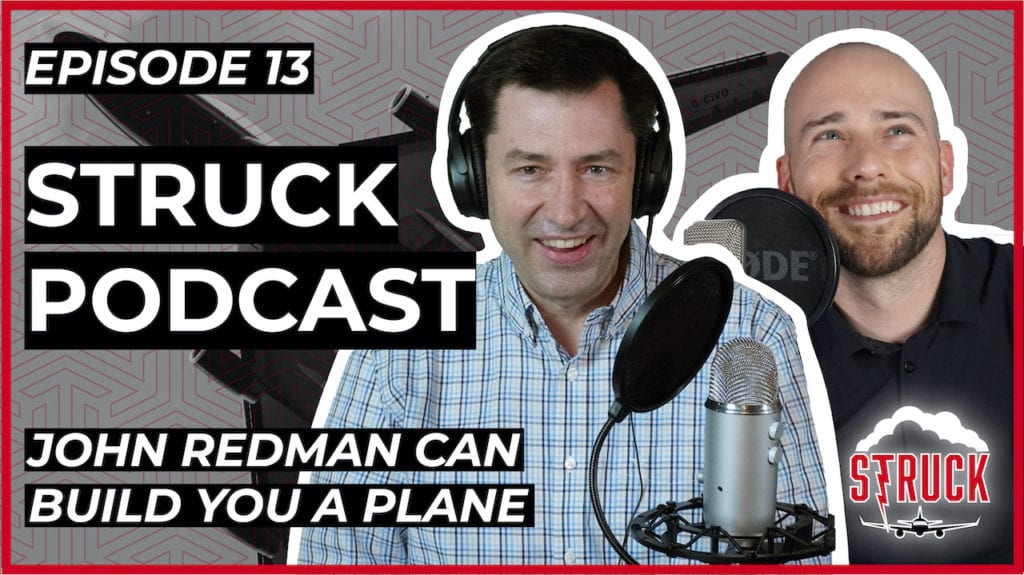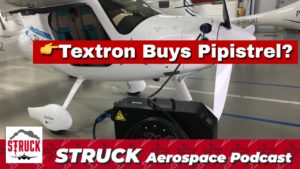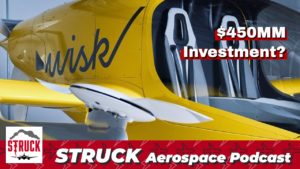John Redman of Viper Aviation is a former Air Force mechanic Crew Chief who worked on F-15 and F-117 fighter jets. Now, he’ll build you your own experimental Rans S20 or Rans S21 plane. Listen in as he tells his story as one of the best USAF mechanics in history, and how he helps those wanting to build their own Rans S20 or S21 aircraft.
Learn more about Weather Guard StrikeTape segmented lightning diverter strips. Follow the show on YouTube, Twitter, Linkedin and visit us on the web. Have a question we can answer on the show? Email us!
Watch the video version of this podcast here.
Get in touch with John Redman right here via the Viper Aviation website.
Podcast: Play in new window | Download
Full Transcript – Struck Podcast EP13 with John Redman of Viper Aviation
Dan: Alright. So we have an awesome guest today. John Redmond, a real aviation lifer is joining us on the show today. I’m having already recorded our conversation with John Allen. What were your, some of your takeaways?
Allen Hall: Well, John’s been in aviation forever and he’s one of those guys you meet Wehrli that has been an aircraft mechanic in the air force.
And then once coming out of the air force has been in aviation ever since. And so he knows the ins and outs of pretty much everything. Aircraft related. It’s hard to find those people anymore because they’re just so [00:01:00] rare. But when you do run across them, it’s always a really good, interesting conversation.
Dan: Yeah. So John started his career off, working on, uh, in the air force, worked on F sixteens and F one 17. So he knows those, those two jets, like the back of his hand. And as also clearly, which he didn’t really go into depth, uh, on he’s worked on some of the, is sort of like. Secret aircraft too, which is pretty cool.
So we’ll just have to imagine. Uh, but he mentioned that a little bit about how he was part of some kind of elite teams there. Um, and then he’s also been the, uh, after his time in the military, uh, was in the model jet engine business, which is also crazy. So these models, um, with. Really powerful jet engines.
Let me think. What do you say? 130, 2000 RPMs and some of these jet turbines?
Allen Hall: Yeah. That’s the full RPM speed and 125 pounds of thrust per engine. That’s all ton of thrust for such a little device.
Dan: Amazing. Yeah, pretty intense. And then he, [00:02:00] uh, he and his son, uh, fly drones for the military now as contractors and.
There’s some really interesting stuff there. A lot of which he also doesn’t doesn’t talk about, but he really gave us a really cool in depth, uh, into an all of his career. And so now he’s, uh, has a new company, Viper aviation. Uh, you can visit them at Viper aviation, usa.com or on Facebook. At Viper aviation and a he’s helping people build their own experimental aircraft.
So tell me, Allen, a little bit about the experimental aircraft industry. Well, the light
Allen Hall: sport aircraft industry is probably 15. Maybe, maybe not that old, but it’s relative, relatively new in aviation world. And it allows you to build your own airplane. You have to build 51% of it. So a lot of it’s, uh, kits that are.
Halfway built roughly. And then, uh, you end up building the rest of yourself and it becomes your own personal little airplane. It is very popular because it is an inexpensive way to get into aviation, having on an airplane, kind of putter [00:03:00] around in and visit local airports and do that kind of thing. So it’s, it is a very, very, very popular thing to do today.
Dan: So, uh, enjoy the conversation with, uh, with John Redman. So really in depth and covers a lot of different levels in the aviation industry. We’re happy to have him. And, uh, without further ado, we’re gonna turn to our conversation with John Redmond.
Hey, John, how you been? How are you doing?
John Redman: No. We’re good. Dan, how are you doing? Hey, Allen. Doing well.
Dan: You’re done. So, uh, number one, thanks for coming on the show. I appreciate it. I’m excited to see you again for, for those of you listening. John’s no friend of mine. Um, we actually worked together many years ago and then, uh, John, you got a new aircraft company.
So tell me a little bit about it.
John Redman: Yes. It’s Viper aviation. We custom build
experimental aircraft for customers as well as paint airplanes for people. We also have an eCommerce store that delivers [00:04:00] carbon fiber fiberglass Aramide materials to fix your callings wheel pants, wink tabs, wingtips, excuse me. Any part of your composite aircraft, sell everything for that as well. So
Dan: basically if I was some rich dude or semi rich dude, and I wanted to build my own aircraft, I could do it myself and then probably crashed into the ground.
Or I could call someone like you. Is that right?
John Redman: Well, hopefully not the, the experimental aircraft that the kits out there understand. They’re pretty much designed to be built by the guy who can change the brakes on his car. You can follow instructions, you can build your airplane. Were a lot of people, it becomes a daunting task is in the electrical part of it.
And the paint, because if you’re going to drop 70 or 80 or $90,000 on an airplane, you want it to look good. So yeah, with the lipstick on the pig, as they call it very well, and the other one is people sit down and tend to find very daunting situations. They’re putting something together and they try and re-engineer it [00:05:00] in their head.
You need to understand that the manufacturer has done that trust what he did and just put it together. As they said, All too often, people tend to go a little overboard. Yeah.
Dan: So let’s talk about the experimental aircraft, uh, like sector in general. You know, you were a crew chief in the air force working on
Mmm. How complex are these planes? And so you say like someone, you can change, their brakes can build their own aircraft, but there’s no, there’s no fail safe. Like when you’re up in the air, I mean, this seems like a very different, like you said, daunting task. So what, what is the, the, the climate of the experimental aircraft sector?
John Redman: Very large continues to grow. Mmm. Everybody who’s flown an airplane. It’s amazing. Most of them tend to start in modeling it’s children, whether it was building plastic models or flying radio control models or control line type models. And it’s interesting how many people have the desire to once possibly build their own [00:06:00] airplane?
The experimental world. It is a world of about 10 million customers out there and they sit down and they just. They want, they want to take the plunge. They say, you know, I can do this. I can change the brakes on my car. Can I really build this airplane? And of course the man and the kisses, absolutely. We got the best instruction manual out there.
What we offer you is a builder assist program where you come and you’ll spend three weeks with us and build your airplane with a team. Okay. I’m going to say highly trained professionals learn processes and programs in the military. That taught me how. To maintain fighters, 500 knots, 500 feet above the ground.
Well, and nine GS and putting bombs on target, never lost a pilot. Then don’t intend to do it today. It’s not difficult. It is different then the standard processes in life. Hmm.
Dan: Gotcha. Yeah, that makes sense. So let’s talk about your time in the, in your, um, in the military. So. I’m working on F sixteens. Like how do you get to the point?
So you recruit chief, [00:07:00] obviously at some point you were like the guy who wasn’t allowed to like, even smell the airplanes
John Redman: when you first get there. You’re, you’re pretty green. he said, okay, go refuel that airplane. And they’re like, okay, you did that and didn’t kill anybody. So now we’re, we might let you put air in the tires.
And through the years of you, you will go through a pretty lengthy tech school, about 16 weeks to learn how to fix the man and maintain the airplane and mainly understand what is called the tech order system that is used to repair the aircraft. It was a very lengthy system, but very well thought out, very processed driven.
And it actually, it makes a lot of sense when you first get it. It just is a whole bunch of numbers on the side of a book. And you’re like, what does this mean? But as you start to use it, you realize it, it did, the process is so thorough and so well thought out. It’s amazing. Absolutely set you up for success.
So after you come to tech school, you go to your first duty station. And like I said, we’re going to let you touch the airplane, but that just touch it. Don’t do anything else. [00:08:00] And through the next two or three years, you’re on the job. Training goes hard and heavy. And next thing you know, you’re changing an engine next and you’re changing a flight control system, et cetera.
And there’s always, I can tell you in the fighter world, there is always something that needs to be fixed. And so there’s never a lack of nothing to do.
Dan: Well, how many of these little things can need to be fixed? I mean, again, all of this to me is an aviation outsider seems scary. Like what you’ve explained that like, Isn’t perfect.
You know, you feel like they have to be all systems go at all times, but I mean, that’s not the case with cars and they still run. I mean, is that still the case with the airplanes?
John Redman: Well, the airplanes, the airplanes, the one thing to remember with an airplane, as long as it’s in motion in the air, it will fly.
If the engine shuts down. You just lower the nose a little bit to maintain a level of airspeed, the airplane still flies. It does not fall out of the sky. And of course the pilot is trained in operating like that in emergencies or things like that happen. There’s so much redundancy built into every system in an [00:09:00] aircraft.
If something drops offline there routinely was another backup system right there online already. That’s ready to deliver whatever level of performance to ensure mission security. Nation’s safety, aircraft safety and our crusades.
Dan: So we were talking a little bit before about, and so you’re talking about how difficult the electrical or the electrical systems are.
Even these rans planes, which are obviously a lot simpler than a I’m talking about the electrical systems and an ethic of 16 or F one 17. How complex are they?
John Redman: They’re they’re very complex. So an F 16 carries about 87 miles of wiring. Oh, next time. You’re in, it’s terrifying. Yeah, go look at, and they’re 16.
It’s not a big airplane. And honestly, if you take the wires out of the stretch, 87 miles. Mmm. The very simple airplane. It has over 1200 feet of wire in it. You learn to troubleshoot that and you sit down and it’s, don’t always assume the part’s bad. You need, you learn when you’re troubleshooting systems like that, you learn [00:10:00] over time through the course of doing it.
It’s like, okay, what else could happen? What was the last type of maintenance was done? Well, we did this last week. Ah, let’s go back in there. Are there any ground lugs near there? You might’ve undone a wire pulling back on and maybe not tightened it enough. That could cause a situation on this system. Is that possible?
Any you trace and troubleshoot like that and it just, but electrical systems and fighters very, very complex and a lot of. Well, engineering goes into them in how they’re done. I mean, the wire’s designed to where it doesn’t burn in our Rand’s aircraft. We use the same type of wire they’re used in military fighters.
I won’t do anything less, probably a little bit overkill. I won’t argue that we have to charge a little bit more for that, but by probation, kind of an in your face kind of guy weren’t in your face kind of brand, we are all about absolutely quality and safety.
Dan: Hmm.
John Redman: So
Dan: who, who’s your typical customer? So is it just a, is it a super wealthy person?
Is it a, like [00:11:00] just a hobbyist, someone like this has been on there, like dreamless for forever. And you’re like who, who typically comes to you guys? Right?
John Redman: More of a dream list forever. So we have a, you know, individuals who I’ve been very successful in life. I’ve learned how to save and put money away and.
Maybe they’re hitting their golden years are 50, 60 years old and everything right. Et cetera, that they’ve got a nice little nest egg put there and they want to build an airplane. And so you can sit down and you can buy a general aviation certified like assessment, one 72, or one 82 for about 150, $180,000.
And it will be eight to 10 years old. Or you can get one of those for about 40 to $50,000. And it’s going to be 40 to 45 years old. Or you can come to us and buy one of ours, help build it. You enjoy that process for just under $200,000.
Dan: And how would you break down the costs of a, of, of a build your own aircraft?
I mean, within the kit itself, um, you know, like ignoring your, your fees and all the other stuff, like, like the components, like [00:12:00] just, if you bought the guts of an airplane, everything ready to go,
John Redman: how does that break down? Let’s talk about, we’ll just talk about an . For example, here, ranches 20, the kid is gonna run you about $37,000.
That’s the main airframe. Then you’re going to look okay. Dollars for the engine, $2,000 for the prop. And then you’re going to look at approximately 15 to $18,000 to the instrument panel and couple thousand dollars for paint. Put all that together. It’s about $75,000. You build it yourself, build it in your garage at your house, assemble it at your hangar.
Go fly. I have a great time.
Allen Hall: Oh, that’s really actually inexpensive because the competing products for that type of person are, tend to be the show, the beach Bonanza, the one 80 twos,
John Redman: which
Allen Hall: new right now, I
John Redman: think. Oh
Allen Hall: yeah. 400,000 plus. Right. So. Yeah, which I understand they’re a little bit larger of an aircraft and they have more systems [00:13:00] and I’m that retractable and that kind of thing.
But if, if you’re not, . Far distances. It doesn’t really make that much difference. Anyway.
John Redman: Exactly. The big thing is you need to, you need to categorize and truly define your mission. I’m going to, I’m going to take, I’m going to go see her parents in Florida every other weekend. So we want to an airplane.
That’s going to cruise at 150 knots or better and be able to get up and out too, so we can get there quicker, et cetera, or is it pleasure flying? You know, I want to go over to this airport a hundred miles away for their pancake breakfast and see a buddy over there. I want to go do this, but I just want to fly to, to be an Eagle for the day.
And I’ll tell you the, the view from 7,000 feet is amazing in it. Okay. We’ve all seen sunsets on the ground, but I’ll tell you a sunset from 6,500, 7,000 feet is something that just, you have to see it to be older. And so you define the mission and it defines the airplane and you can get experimental aircraft out there.
That’ll cost upwards of 300,000 bucks, and they’re going to push you down through the skies at 170 knots, 200 miles an hour and great cross country birds, [00:14:00] et cetera. Just cost more money.
Dan: So when you use the term experimental and CRA aircraft, why that term, like, what does it mean?
John Redman: Okay. Okay. That’s that’s, that’s a great question.
So in the world of generalization, we have certified aircraft. That’s your assessment is your beach, craft your Pipers, et cetera. Now, with those, you as an owner, Cannot do any real maintenance on it. You can change the oil change, check the air on the tires, et cetera, but that’s it. Anything that’s done has to be certified accomplished by a certified airframe and powerplant individual.
And with that, he comes with those 70 to $130 an hour rates to repair your airplane. And then we have certified parts. Parts would have to go through the concept of being certified that they’re not going to fail. Et cetera. And it’s all the world of liability when it comes to that for parts manufacturers.
So a certified airplane is not a cheap aircraft to maintain and [00:15:00] experimental aircraft that you’re allowed to build yourself. And as you build it, you get what’s called the Dar, which is an airworthiness certificate and you become the perfect on that aircraft. So if I build my airplane here, just me. Yeah, I get it.
And I fly for five years and I sent it to sell it to you. Dan, at that point, you would require an amp mechanic to maintain it. Cause you’re not there. So you’re not the mechanical record, but I’m the mechanic of record. So when I’m maintaining my airplane, I don’t have to pay those outlandish labor fees as well as certified parts.
I’m not required to use certified parts because the aircraft can never be used for hire. Now here at Viper aviation, we. Find it in between there, for example, uh, aluminum fuel fittings screw into like fuel tanks, et cetera. There’s a company there and fittings. Now they’re the same fittings that are used on certified aircraft.
But when you buy that and fitting the certified for flight, we’ll just say this 90 green nipples, 65 to [00:16:00] $75 where I can go down to the local hot rod or speed shop and buy it for 12 st. Fitting. But it hasn’t, it hasn’t gone through and got that certified tech. Right.
Dan: So it kind of reminds me of like the, uh, organic, I mean, I know you said you’ve been on the health, on the health up and up, right.
You’ve been great, eating healthy and exercising a ton and all that stuff. And if you talk about organic food, a lot of it isn’t really necessarily better than regular food. There’s obviously some difference, but also now more than ever there’s companies that grow their products organically, but they’re not technically organic.
Because they didn’t go through the certification product or process, which can be really lengthy and expensive for a small farm, for example, to get their lettuce with the official organic stamp, even though it was grown as organically as someone that has the stamps. So it seems like it’s kind of that same thing.
John Redman: Yes.
Dan: Yeah. So, okay. So. Now, how do you know though that the same fitting at the local hot rod [00:17:00] shop is really the same as the certified one? How do you know for sure, especially with more complex parts, like say it’s some kind of wiring or, um, like a switch or just something that’s not just a little block of, of brass.
John Redman: Okay. So with wiring, there is aviation grade wiring and we buy it from an aviation grade supply house. Mmm. Same within there’s bolts, nuts, washers, such cetera. Those. Most of those we buy are certified parts because they’re made in such, you know, extreme non mounts. It, the prices are reasonable. That’s not a problem.
We don’t play there with like the a and M fitting. If you hold two in your hand, you can’t tell the difference. Okay. My belief, this is just John Redmond speculation. Sometimes that could be scary, but. I’m guessing that both are made from the same dyes, the same tools, the same taps, et cetera. And then one has to go through a certification process.
So it gets another part number on [00:18:00] it. And that’s the only difference. Yeah. Brand new guys. Oh, I can get eight ed fittings and China. They’re only $2 a piece. Good for you. The ones that are paid in America, maybe those are fine, but I love it once made in America. Thank you. Yeah.
Dan: Yeah. So I assume that your customers need someone like you to kind of understand the market, right.
To say like this one’s okay. This one’s okay to not go certified in this one. You definitely don’t want to cheap out on, is that right? Right. Yeah. That makes sense.
John Redman: We work our best at, uh, you know, if you look at our website, we list a number of items that are included, and one of them is called a vertical power system, which we don’t have any circuit breakers nerves from the panel.
All of our circuit breakers are solid state 21st century. It’s an electronic box that sits down. So when the breaker pops, it’s gonna pop up on your screen and say, you know, Hey circuit, breaker pop, you can push and reset it. But when you land, go ahead and check it out and see what’s going on. And it will give you [00:19:00] data as to, well, you know, for eight seconds, it was at eight amps since there were normally only pulls four amps.
So it can possibly give you some more information they’ll troubleshoot. And I’ve ran into some of the old gentlemen out there, like, well, I want a circuit breaker box. Okay. Orville and Wilbur did it that way. And it was a great way to do it, but it’s 21st century and Airbus and Lockheed and Boeing have showed us other ways to do it.
That’s still what kind of your approach we’re doing 21st century.
Dan: Gotcha. Gotcha. So let’s kind of go back a little bit, a bit to, uh, your, your military stuff again. So obviously these are really, really expensive aircraft. They’re on really important missions. Um, how much pressure does that put on a mechanic knowing that like these cannot crash, that these are extremely expensive, that these pilots are very high train and I’m sure very demanding of you.
Um, what is it like to be a military mechanic?
John Redman: Um, the stress is there. There’s no doubt about that, but every time you see him light, the burner rolled down the runway, put the gear in the [00:20:00] well and depart, Hey, there’s an absolute level of satisfaction knowing, you know, I sat down and I know every inch, every wire in that airplane.
And I flipped every switch, everything he’s touching is me. And I’m not here to let him down because even though I may not like this pilot personally, I’m going to guarantee he comes home to his family. I want his daughter to see him at dinner tonight. And it’s just, that’s part of that. I would say the mentality of actually the military.
He’s one of my brothers or my sisters now. So we had a woman in there in the cockpit. I’m not going to let anything happen to them. I am going to kill myself to ensure they continue their mission. And that’s just the military training and mindset we’re there. And we’re all there fighting for the same process and program, which is a red, white, and blue flag that flies outside.
You do whatever you can to ensure. Everything for them is going to work because if it doesn’t, it’s a bad day.
Allen Hall: How much time did you spin? Just . How many years did you do that?
John Redman: 13 and a half. Wow. [00:21:00] Yeah.
Allen Hall: At what point, at what point did you think you really knew the aircraft? How many years
John Redman: in did you probably at about four years, I felt very confident, um, in a positive note, all of us with our arrogance and men and trying to be the best guy out there, probably thought about a year.
I know what tells going on it. And that was not the case. Would you would get humbled very quickly. And the great thing is, is, you know, the pilots. They had pilots out there and lieutenants, you know, 250 hours, they think they know everything about flying enough, 16, and they’re talking to the guy who’s got 1500 hours.
They get home humbled and we all just humble each other effortlessly and regularly. Yeah. You just, you work together and it’s like, no, sir. Why did you do that? Really? That chief, are you sure? No. Right. I would say that the one that was interesting is one of the greatest, I’ve had a couple of compliments in my life that I was very proud to receive.
One was I got called into an office. Ah, I was [00:22:00] four years in the military and three and a half years in the military and I’m sitting behind a desk and there’s a Lieutenant Colonel and he’s asking me some very pointed, unique questions. And I’m saying like, do you have a girlfriend? Your marriage stable.
Does your wife have a boyfriend? You’re like, what are you talking about? And he sits down next to those. And he said, well, I have a statement here from now, Sergeant Willison, do you know him? Yes, sir. I do. He says you’re the best F 16 crew chief theory of course has ever seen. Well, hot dog. I’ll take that.
You don’t want to just, what does that have to do? This is why I know Sergeant Eisner. He says this it’s true. Okay. And a number of months later, I found myself on a very unique Arrowhead shaped black airplane at a remote location in the Nevada desert or on an airplane. That was all part of the kind of an interview.
It was funny. And there was another time I was in the backseat of 38. Yeah. My pilot is my commander. He [00:23:00] goes red. Yes, sir. He said. You’re never going to see more than six stripes in this man’s air force. Good. Yes, sir. He says, I don’t care if you saved the white house. If you marry the president’s daughter, save the General’s daughter, doesn’t matter.
You’re never going to see more whites. Is it your mouth? Yes, sir. Mmm. I tend to say what I think. And don’t always think before I speak and he goes, but I will tell you this. If we were ever to put a crew chief in a glass case that said breaking case of war, you’d be that guy. I said I’ll take it. Yeah, that’s true.
Dan: Yeah. It
Allen Hall: it’s, it’s always amazing how much training and effort goes on, on the mechanical side of airplanes and electrical side. I, I, I’m always, when you run across a good mechanic in aerospace, you know,
John Redman: it pretty quick. Right, right. And a
Allen Hall: lot of those, a lot of those people come out of the service. Most of them do I think.
And it’s just because that’s what they do all day. Every day, they’re focused on that one thing.
Dan: Right.
Allen Hall: And it’s like a college degree. [00:24:00] In some cases, it’s kind of what it is. , everybody’s enlisted. Right? All you guys enlisted
John Redman: and
Allen Hall: spend all that time. And how many times did you have to move? When you’re in the service?
John Redman: I moved a total of seven times. Wow. That’s hard on a family. And I really, Dan met my ex wife, Tammy. She was a phenomenal lady, a phenomenal woman, a phenomenal mother, phenomenal wife. And I mean, I never had to worry about any thing at home. Uh, when I was work or deployed, I knew it was a hundred percent taken care of and I, my kids were always cared for.
There was no issue. No worries. So when that’s not weighing on you. Of course, it allows you to be even a better mechanic at work. Yeah.
Allen Hall: That’s, that’s the hard part of being in the service, right.
John Redman: It is.
Allen Hall: And not knowing, and then being called away at a moment’s notice and you just don’t have any say in it.
John Redman: Yeah. Right. Get you, get your gear. You’re going. Wow. That that’s, [00:25:00] that was the program. It was interesting when desert shield kicked off and the whole United States air force went to Saudi. Yeah. The F one 17 guys didn’t. Hmm, we’re supposed to be at the tip of the spear. We don’t get to play in the super bowl to what’s going on.
Just go to work, just go to work a month and a half later we finally deployed and it just, for whatever reasons, I don’t know, didn’t need to know what people above me knew. You know, we were still going to be there, but we did. Hmm. Deploy with the week. We got there later on when it was time for us to be there, I guess.
Yeah. So the initial rejection, all of us were like, why are we not going now? Don’t worry about it. Go to work. So
Allen Hall: when you deploy it to Saudi Arabia, what are the conditions like
John Redman: out there? They were actually not bad for us. I mean, so we were with the most unique, fragile little child plate of a. Fighter in the history of aviation, your airplane has to be maintained in an air [00:26:00] conditioned or heated hangar.
You keep it at 60 to 82 degrees. That’s it? It can’t be too hot. Can’t be too cold. We’ll hurt the little baby. And so with that, you know, the hangers were always nice. Saudi, 140 degrees outside, keep the doors closed. It was 75 inside the hangar. So that was kinda nice. And then we also, where we were, I don’t know the bill of goods, it was sold to the Saudi people, but we weren’t staying in tents.
We stayed in apartments. Regular bed.
Allen Hall: Yeah. They always say the air force gets
John Redman: treated a little bit better than the army. The chair force. We need our associates and we need to have our catered meals, but with a stealth fighter, it carried such uniqueness about it. We got treated very, very well. I deployed over there with sixteens where I stayed in tents chance were conditioned, you know, and the showers were brackish water.
Yeah. You were able to get the dry mafia. [00:27:00] Food was always decent in the air force, no matter where you went. Okay. That’s also true. Yeah.
Allen Hall: Right. That’s that’s why my, my father was in the air force for yeah. He enlisted also, I was an electrician on aircraft for a long time and yeah. Mmm. I know. That’s one of the things that when he came out of the service, he just had such a skill set, uh, that made him immediately
John Redman: employable.
Allen Hall: Right. Yeah. I think that’s one of the things that I know a lot of, you know, people lot to think about, especially the air force, because you do come out with that immediate set of skills. It’s so important today to have that set of skills, because it really sets you up in a career for most your life. Like look at you.
John Redman: Yeah. You’ve
Allen Hall: got a long ways. Right. You’ve got a long way. It’s
John Redman: just,
Allen Hall: yeah. Yeah.
Dan: So let’s, so let’s, let’s run with that. Uh, so after you left the military, Mmm, you were doing, uh, hobby jet engines, right? You’re basically
John Redman: for jet at USA in van Nuys, California. [00:28:00] And I basically manage the repair shop and sales for the United States.
And it was interesting flying model airplanes and flying jets. I’m I’m down there talking to the owner of the company wants, needed sponsored me and the owner of the parent company from Germany came over and we’re talking. And I look as gentlemen name was Marcus zipper, and I said, Marcus, why are you scheduling this engine to operate like this?
I said, you’re making a mistake. I can tell you I’ve turned a lot of 25 to 30,000 pound after burning jet engines. And the way this is scheduled, it’s not like that. I see. Do you mind if I adjust it? So he opened up the engine control unit and put it into a mode where I could change some of the settings.
And about 30 minutes later, I said, run that telling me what you think he goes. How did you do that? This change, this change, this it just, you know, so it ended up that at that point. Um, yeah, we’ve become great friends. We’re great friends to this day. Mmm. It just did that for a number of years. And then from there, [00:29:00] I went into the hobby industry and designed model airplanes for horizon hobby and East flight keep two airplanes over five years.
And at that point in time, I went there. I told the, uh, My, my vice president. I said, I don’t know anything about electric motors. He’s just, I don’t care. I can teach to that. What I need is your ability to make the plane fly so good. The average consumer can be successful. That’s it? Okay. And so it’s interesting.
As you know, as I left there, there were two airplanes that I designed that are still in production today. One is the, uh, uh, parks on two 28. We sold over a million of those. Over the course of about 10 years, which was crazy. It was a very iconic model airplane chunk of foam. And another one was called the apprentice and more people have learned to fly on the apprentice than anybody, and it still sells today and it still has record sales numbers.
So, mm, a couple of my cap feel good about,
Dan: and how big are these? I [00:30:00] mean, these are jet. These
John Redman: are jet model, propeller driven aircraft, boom spans. Mmm. You know, you throw them in the back of an SUV and go to the park and fly and have a good time. You know, I, I flew jets. That was my main focus through my entire military life.
And, uh, my main, a hobby life was flying airplanes at 200, 200 5,300 miles an hour. I’ve flown for Boeing, a phone for NASA doing that. And we actually do that now on our counter UAS program as well. We’re getting ready to head to China Lake and fly some 280 mile an hour jets to get radar systems to determine.
Like how they can defend against these, if the bad guys start to use this stuff.
Allen Hall: Wow. Hey Dan, have you seen those kinds of engines? Have you seen that? Because they are really jet engines. They’re not ducted fans. Like you used to be a long time ago. There are actually jet engines. Uh . The complex little beast, but it’s amazing.
They can make in that small and it’s [00:31:00] reliable. And if you watch some of the model airplanes with those things, it’s just incredible. And
John Redman: I can remember showing up some tech reps from Pratt and Whitney and general electric at Edwards air force base. One day I had my took my mic 15 and to show everybody, and they came down and watched it Island at 32,000 RPM, full throttle, 130,000 RPM.
Wow. Yeah,
Allen Hall: 130,000 RPM
John Redman: at full throttle. Yes.
Allen Hall: Wow. Okay. That’s the same sort of jet engine that they use, like on the guys have little, the wings that are flying around Dubai.
John Redman: Yes. Yes. In fact, those are checked cat engines. Are they okay? Yes. Jet man and jet man devise jet had engines. He’s Rossi. No, we use Rossi brake guy.
Yeah. Yeah. He used to drive a seven 47. Now he flies around like Superman.
Allen Hall: Yeah, the, the video team, we got to show the video of that, uh, cause they’re flying next to an 83 80 in Dubai, that time information and there’s foreigners for jet engines on that wing.
John Redman: Right, right. Are [00:32:00] 125 pounds of thrust a piece.
So the guy’s got 500 pounds of thrust on board that airplane.
Allen Hall: So it’s like a two to one thrust to weight
John Redman: ratio. Right? Right.
Allen Hall: Holy moly.
John Redman: Yeah.
Allen Hall: Wow. Okay. So there’s, there’s plenty of thrust to, to everybody. They want
John Redman: to go do exactly.
Allen Hall: Okay, so that obviously it has implications now in the sort of the safety and security
John Redman: world, because absolutely.
Yeah.
Allen Hall: And you can deliver cargo with those things pretty quickly if you’re not careful.
John Redman: So what
Allen Hall: is that? What does that look like now? Obviously, uh, the government and FAA and everybody is border patrol. Uh, alerted to these things because a lot of times the aircraft modeling world comes up with the most unique designs, but longer for the aerospace companies too.
Right.
John Redman: Right.
Allen Hall: So what, what is involved in all that now? Like what, what are they trying to look at? How are you involved in some of those things?
John Redman: The FAA with the world of, we’ll say, Amazon wanting to deliver with drones and Google [00:33:00] 20 deliver with drones, it’s really truly defining the American airspace. So the national airspace.
Mm. And so in the past, General aviation doesn’t fly below 500 feet or populated areas or just, they’re not supposed to. Right. And so from ground level of 500 feet was never an issue. And the models have always had a, had a basic ruling that stable of 400 feet that gives a a hundred foot separation, never problem.
And then you’re out away from the world and you go higher. It’s not a problem. There’s nothing there, but it is really under scrutiny right now with the FAA, trying to determine how to redefine the national airspace. A lot of hobbyists think the FAA is after him and out to get them. And that’s not the case.
I believe it’s a whole new process for the FAA just as it was. I’m going to say back in the 1930s, when they were trying to shut down barnstorming, because they saw what was going to happen with commercial, where travel, package, your delivery, et cetera, and air mile. And so they’re having to redo that again, and it’s, it’s gonna be a [00:34:00] lengthy process and it’s not going to be perfect on the first day out.
It’s probably going to upset some people and bend a few bumpers, but they’ll all get the one thing the FAA, I believe. It’s very good at it. It’s finding a general mix and the way it works out and becomes successful for everybody. Yeah.
Allen Hall: And Dan, one of the things that happened relatively recently is they wanted you to register,
John Redman: well, you may have done this, right.
We’ll just show the drone. Right, right. You’re on $5, a drone. And it’s so it’s interesting. What happens when you crashed that then is dead where you go to buy another one. So you gotta spend another $5. So the end result is you call your new one, the old one, right? Exactly.
Dan: Well, I actually bought this new one that was, they engineered to be one gram under the weight where you had to register it.
It’s called the Maverick of Maverick mini. I think it was 209, 299 grams. Maybe something like that. I have it over here somewhere. Of course I can’t fly it. I’m in D C so I. If it’ll ever leave my apartment, just be shot down immediately, and then I’d be thrown in jail. But, [00:35:00] um, you know, if I ever get outside the city limits far enough, then I can start to use it again.
Right, right. But yeah. Okay. So speaking of, uh, airspace, how do experimental aircraft fit into that whole thing? I mean, they’re higher than drones. They’re higher than models. They’re lower than commercial. Like
John Redman: how does all that work? So they, they fly in the same airspace assessments, Pipers Cherokees, and beach crap, general aviation aircraft.
So you have multiple types of aerospace. You have class B, class C West, the class G airspace class G is pretty much anywhere. It’s not controlled by anything. Class B is right around an airport, et cetera. And it’s tiered for airliners to come in and land. And so they make sure that in those tiers and they know exactly where you are, that ensures absolute safety for all commercial airliners.
Um, and so we just operate anywhere. You’d fly assessed in one 70 to one 82 and up to 18,000 feet, you can talk, you can fly. In an open [00:36:00] airspace without talking to anybody. Once you hit 18,000 feet, you now have to talk to the FAA, normally their centers, uh, as they’re called their fair traffic control center so that they know you’re there.
Anything the airspace between 18 to 60,000 feet is absolutely controlled in the national airspace. No matter what, above 60,000 feet, it’s not controlled again. Normally the only people operating there is very high level military aircraft, no civilian stuff’s operating there. Yeah, they want the military to do their own thing.
Gotcha.
Dan: So as, as part of like your, your build assist, uh, with
John Redman: Viper,
Dan: do you help people with any of that sort of stuff, like understanding what they should and shouldn’t do as air craft operators? Or I guess just tell me in general about your, about your program.
John Redman: So no, you come to us, you’re a pilot. We don’t, we’re not here to teach you how to fly or any of that.
Now we do offer possibility of what’s called transition training. So where you can climb into any rental card [00:37:00] around find they’re all about the same. You drive them. But you know, every car has its own little ports airplanes the same way. Now, the big thing with airplanes is stall speeds are different and cruise speeds are different.
And what called VNE never exceeds speeds are all different. So that’s part of your transition training to understand the requirements, your airplane, to keep yourself safe in that airplane, safe all the time. So we’ll help you with that. But the builder assist program we offer is a little different than everyone else’s in the industry.
Other companies that do it, you have to go there for three weeks straight. And trying to dedicate three weeks of your life, we believe is tough for most people. Yeah, for sure. Next round trip, airfare tickets from anywhere in the 48 United States to Houston, where you in a significant other, because we have the prices of these, normally the wife’s involved and she likes to be amongst your team.
So where you both fly out to us for three different weeks, maybe one week, this month, one week next month, one week, the next month, everybody can normally find a week in their schedules to do that. As you come out here to [00:38:00] us, we’re going to put you up in a Hilton property, probably in Hampton and soon to be right next to the facility.
And we’re going to give you a rental car. Food is on you, and now you will work intimately with a team, building your wings, building your fuselage, covering your airplane, whatever it is. So that point, and then you go back, we continue to build the aircraft. And during that time, our process, you will be briefed every Monday as the team is briefs for the pro, what’s going to happen that week.
And at the end of the week, you’re going to get an update of what was accomplished and what is set for next week. So you are in tune with the bill the entire time. That’s our builder assist, where it gives you an opportunity to not, we’ll say dedicate a month of your life, which is very
Dan: difficult. Yeah.
I’ll doing little chunks and stuff. That makes sense. Yeah. I think that makes sense. So, um, So what other little, little things do you do to support pilots who maybe aren’t buying an entire aircraft for you or from you?
John Redman: The one is, is our, our goal is to deliver instrument panels and wiring harnesses to anyone building an
So that’s still in its [00:39:00] infancy. Now we’re not quite there yet, but the goal is if you built, I bought a nest 21 or an S 20 kit, and you’re building it yourself. Doing the instrument panel can be a daunting task and the harnesses. Well, like I said, we’ve got about 1200 feet of water in this airplane. Well, what if you could call Viper aviation and pay $2,500 and all your hard wire harnesses, just come in a box connectors, you literally plug and play and you wire your airplane in a day and you just take it out right bolted into your airplane, plug it in, and you’re ready to go.
Trying to help help the consumer with parts of the build that can be daunting and difficult to understand.
Dan: Gotcha. And then you also sell, so for people that already have a plane who just need to maintain it, um, do they have anything from you guys on the website or what do you guys do for them?
John Redman: So, uh, what we, what we have is, you know, we have lights, wingtip, lights, et cetera.
We have, uh, all of the avionics packages will be available to screens if you need those switches, et cetera. But [00:40:00] more importantly, if you’re pulling your airplane out of the hanger and you didn’t open the doors, Enough and you bump your wink tip and crack your fiberglass wing tip. Call us. We’ve got fiberglass.
We’ve got carbon fiber. We’ve got Aramide. We also carry the world’s greatest aviation grade resin fault. Mgs epoxy. Now mgs epoxy. You can only buy when you normally work. a gap. It’s $250. Well, epoxy it’s you don’t use it all in it’s certain time. It doesn’t have a shelf life and it goes bad. So, what we do at Viper aviation is we have repackaged that resin two smaller quantities where you can get three ounces, six ounces, 12 ounces, or 24 ounces, depending on your application and what you need.
So that way you don’t have to spend $250 and then put it up on the rafters. And two years later, you go up there and it’s all solidified bad. We try and we’re trying to help ranked market for the, for the consumer, the finest grade products. He [00:41:00] can get. But also in the quantities that he actually needs.
Dan: Yeah. That makes sense. Because most people aren’t buying for the whole hanger. They’re just buying to, like you said, just
John Redman: exactly
Dan: Nixon, scratches, and little repairs.
John Redman: You crack your wink tip. If you go to some of the main aircraft houses, you can buy carbon fiber fiberglass, but you have to buy five yards Arbonne fibers, the nickname, black gold.
I mean, Our carbon fiber is $9 a foot. So it’s $36 a yard. If you got to buy five yards of that to fix a four inch crack, that’s a little frustrating. So with that, we’ll sell it by the foot. Well,
Dan: um, John, this is a really interesting conversation. I mean, you’ve been in so many different areas of aviation. I mean, from the military, the.
Aircraft that you probably can’t speak too much about. And obviously like the high end hobby and the drones, and now helping people build their own Rand’s aircraft. It’s a, it’s a pretty crazy journey. You’ve been on it. You still got, how long do you plan on living? Do you, if they get [00:42:00] cyborg technology, John D are you going to.
John Redman: Bootstrap I’m going on.
Dan: Well, I gotta ask you one more question before we go, and I appreciate that. So it’s been, it’s interesting to see us kind of go full circle as friends over these years, but yeah. Mmm. Two pieces of tech that I, I am excited for. The future are one self driving cars. Um, too. I also just think the idea of.
The way they can repair people in the future. Like, I, I jokingly mentioned becoming a cyborg, which we’re all slowly becoming cyborgs with our phones and all this technology, but what, what’s a piece of technology that you really look forward to that you think either, you know, is coming or maybe you think is
John Redman: coming.
That’s interesting. Never thought of that. That’d be,
Dan: that’d be something in the aviation world now,
John Redman: you know,
Dan: self-driving so flying planes.
John Redman: Yeah. Air buses that carry people. It’s interesting. Those guys dial in the airport and they dial in the altitude and they dial in the airspeed in the airplane, lands itself.
[00:43:00] Pilots are still up there and I still manage and maintain and do all that. But the aircraft has the ability. So the self flying programs already done they’re a little more
Dan: bold than most. I think it’s really cool to think that, I mean, you were talking, we were talking off camera about you driving out and picking up an aircraft.
What, if you could do that, not to drive yourself, you just get in the car and then it takes you there. Get it, come back. Yeah. Just sleep. Do work the whole time. Be amazing. That’s what I’m looking forward to. Yeah. Well, John, thanks again for being on the show. Really appreciate it. And good luck with, with Viper and everything else.
John Redman: All right. Appreciate it. You have a great day. All right.
Dan: So if you’d like to follow up with John and his company, Viper aviation, you can do so on the web at Viper aviation, usa.com and also there on Facebook at Viper aviation. So again, really a profound conversation he’s to been around so many different.
He’s had his hands in so many different aircraft over his years in the [00:44:00] military, on the hobby side, on the drone side, and now helping people build their own experimental. Ron’s aircraft. So if you, uh, if that’s something you’re in the market for, I mean, he’s just a, uh, a super knowledgeable, you can tell how passionate he is about not only just building aircraft, but keeping people safe in them.
You know, like he said, you know, his pilots were his brothers and he wanted to make sure they came home safe. So I know if you’re in the. In the market for something like that for yourself, not, not a military jet aircraft, but uh, your own, um, experimental, you know, hobby aircraft, then it seems like the guy to turn to.
So again, want to thank John Redman Viper Aviation for being on the show and, we’ll see you here next week on the struck podcast.












